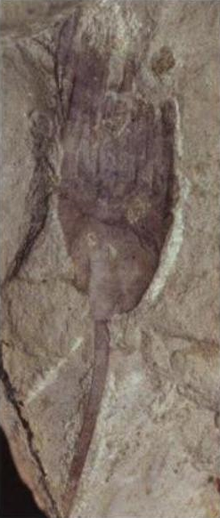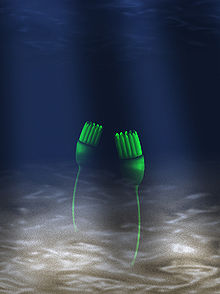- Dinomischus
-
Dinomischus
Temporal range: Chengjiang–Burgess shale
Dinomischus from the Chengjiang Scientific classification Kingdom: Animalia Genus: Dinomischus Type species Dinomischus isolatus
Conway Morris, 1977Species - D. isolatus
- D. venustum
Dinomischus is a rare fossil animal from the Cambrian period. It reached 100 mm in height,[1] was attached to the sea floor by a stalk, and looked loosely like a flower. The cup-shaped body at the top of the stalk probably fed by filtering the surrounding seawater, and may have created a current to facilitate this.[2] Its mouth and anus sat next to one another.
In his pioneering excavations of the Burgess shale, Charles Doolittle Walcott excavated the first, and at the time only, specimen. It had evidently caught his eye, for he had taken the trouble to carefully photograph it - but he never found the time to describe the organism, and it was not until 1977 that Simon Conway Morris described the animal. He tracked down two further specimens, collected by further expeditions by teams from Harvard and the Royal Ontario Museum, allowing him to produce a reconstruction.[3]
He was not able to say much about the organism. It consisted of a calyx (or body) on a long, thin stalk, surrounded by a whorl of 18 short "petals" which enclosed both openings of its U-shaped gut.[1] The presence of this gut identified it as a metazoan, and the stem implied that it lived permanently attached to the sea floor by a small holdfast.[3] The twenty or so "petals" borne by each organism were solid, plate-like structures, about two thirds the length of the calyx. It is speculated that they may have been covered with cilia - fine hairs - which would have wafted food down towards the organism's mouth.[3] A number of affinities were considered, but on the basis of available evidence it didn't quite seem to fit into any extant phylum.[3] The most similar organisms were the much smaller entoprocts, but even these modern organisms are difficult to classify.[4]
Further specimens have since been produced by similarly spectacular fossil sites in China. 13 have been found in the Chengjiang, then in 2006 one specimen was identified within the Kaili biota.[5] These organisms merited the erection of a new species, D. venustus, as their corrugated "petals" possessed radial rays.[6] However, these new data have added little to the debate; while a suggestion of echinoderm affinity has been floated,[7] no phyla are compellingly similar to the organism.[8] Other modern ideas, even if a little tenuous, include a suggestion that the organism may have been parasitic, dwelling on the carapaces of larger organisms.[9] 13 specimens of Dinomischus are known from the Greater Phyllopod bed, where they comprise < 0.1% of the community.[10]
Dinomischus is not the only organism of its kind in the Cambrian; a similar, larger organism known as the "tulip animal" has also been recovered, but not yet described, from the Burgess shale.[11] It has also been likened to Eldonia and Velumbrella, although unlike Dinomischus these medusoid organisms have tentacles.[12]
References
- ^ a b Hou, X.-G. (2004). The Cambrian Fossils of Chengjiang, China : The Flowering of Early Animal Life. Blackwell Publishing. ISBN 1405106735.
- ^ "Dinomischus isolatus". Hooper Virtual Paleontological Museum. http://park.org/Canada/Museum/burgessshale/misc1-3.html.
- ^ a b c d Morris, S.C. (1977). "A new entoproct-like organism from the Burgess Shale of British Columbia". Palaeontology 20 (4): 833–845. http://palaeontology.palass-pubs.org/pdf/Vol%2020/Pages%20833-845.pdf.
- ^ Lieberman, B.S. (2008). "The Cambrian radiation of bilaterians: Evolutionary origins and palaeontological emergence; earth history change and biotic factors". Palaeogeography, Palaeoclimatology, Palaeoecology 258 (3): 180–188. doi:10.1016/j.palaeo.2007.05.021.
- ^ Peng, J.; Zhao, Y.; Lin, J.-P. (2006). "Dinomischus from the Middle Cambrian Kaili Biota, Guizhou, China". Acta Geologica Sinica 80 (4): 498–501. http://www.cqvip.com/QK/86253X/2006004/22687085.html.
- ^ Hagadorn, J.W. (2002). "Chengjiang: Early Record of the Cambrian Explosion". In Bottjer, D.J.; Etter, W.; Hagadorn, J.W.; Tang, C.M.. Exceptional Fossil Preservation: a unique view on the evolution of marine life. Columbia University Press. ISBN 0231102550. http://books.google.com/?id=pxlv0KbjfO4C&dq=Dinomischus+venustus++Dinomischus+venustus+Chen,+Hou+%26+Lu,+1989.
- ^ Chen, J.Y.; Zhou, G.Q. (1997). "Biology of the Chengjiang fauna". Bull. Natl. Mus. Nat. Sci. 10: 11–105.
- ^ Morris, S.C. (1987). "Cambrian enigmas". Geology Today 3 (3–4): 88. doi:10.1111/j.1365-2451.1987.tb00495.x.
- ^ Bassett, M.G.; Popov, L.E.; Holmer, L.E. (2004). "The Oldest-Known Metazoan Parasite?". Journal of Paleontology 78 (6): 1214–1216. doi:10.1666/0022-3360(2004)078<1214:TOMP>2.0.CO;2. ISSN 0022-3360. http://jpaleontol.geoscienceworld.org/cgi/reprint/78/6/1214.pdf.
- ^ Caron, J. -B.; Jackson, D. A. (October 2006). "Taphonomy of the Greater Phyllopod Bed community, Burgess Shale". PALAIOS 21 (5): 451–465. doi:10.2110/palo.2003.P05-070R.
- ^ Fletcher, T.P.; Collins, D.H. (2003). "The Burgess Shale; Associated Cambrian Formations West Of The Fossil Gully Fault Zone On Mount Stephen, British Columbia". Canadian Journal of Earth Sciences 40 (13): 1823. doi:10.1139/e03-057. PMID 36140. http://proquest.umi.com/pqdlink?RQT=318&pmid=36140&TS=1221280314&clientId=12520&VInst=PROD&VName=PQD&VType=PQD.
- ^ Dzik, J. (1991). Is fossil evidence consistent with traditional views of the early metazoan philogeny?. pp. 47–56. http://www.paleo.pan.pl/people/Dzik/Publications/traditionalDzik.pdf.
Further reading
- Briggs, Erwin & Coller (1995). Fossils of the Burgess Shale. Smithsonian Institution Press. ISBN 156098659x. OCLC 231793738.
- Hou, X.-G. (2004). The Cambrian Fossils of Chengjiang, China : The Flowering of Early Animal Life. Blackwell Publishing. ISBN 1405106735.
- Knoll, A.H. (1996). "Daughter of time". Paleobiology.
Categories:- Burgess Shale fossils
- Maotianshan shales fossils
- Incertae sedis
Wikimedia Foundation. 2010.

